Habitat: Found in palmettos and scrubs, swamps, pine woods, and flatwoods. It has been observed swimming many miles out in the Gulf of Mexico, reaching some of the islands off the Florida coast.
Length: Average 1.4 meters, maximum 2.4 meters.
Distribution: Coastal areas of North Carolina, South Carolina, Louisiana, Florida, and the Florida Keys.
Eyelash pit viper
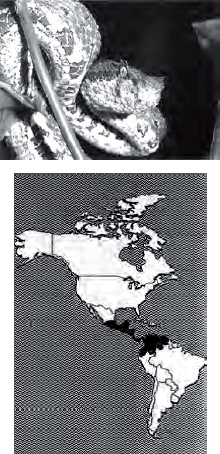
Bothrops schlegeli
Description: Identified by several spiny scales over each eye. Color is highly variable, from bright yellow over its entire body to reddish-yellow spots throughout the body.
Characteristics: Arboreal snake that seldom comes to the ground. It feels more secure in low-hanging trees where it looks for tree frogs and birds. It is a dangerous species because most of its bites occur on the upper extremities. It has an irritable disposition. It will strike with little provocation. Its venom is hemotoxic, causing severe tissue damage. Deaths have occurred from the bites of these snakes.
Habitat: Tree-loving species found in rain forests; common on plantations and in palm trees.
Length: Average 45 centimeters, maximum 75 centimeters.
Distribution: Southern Mexico, throughout Central America, Columbia, Ecuador, and Venezuela.
Fer-de-lance
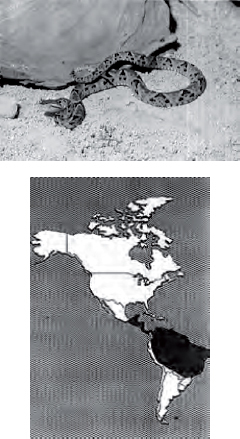
Bothrops atrox
There are several closely related species in this group. All are very dangerous to man.
Description: Variable coloration, from gray to olive, brown, or reddish, with dark triangles edged with light scales. Triangles are narrow at the top and wide at the bottom.
Characteristics: This highly dangerous snake is responsible for a high mortality rate.
It has an irritable disposition, ready to strike with little provocation. The female fer-de-lance is highly prolific, producing up to 60 young born with a dangerous bite. The venom of this species is hemotoxic, painful, and hemorrhagic (causing profuse internal bleeding). The venom causes massive tissue destruction.
Habitat: Found on cultivated land and farms, often entering houses in search of rodents.
Length: Average 1.4 meters, maximum 2.4 meters.
Distribution: Southern Mexico, throughout Central and South America.
Jumping viper
Bothrops nummifer
Description: It has a stocky body. Its ground color varies from brown to gray and it has dark brown or black dorsal blotches. It has no pattern on its head.
Characteristics: It is chiefly a nocturnal snake. It comes out in the early evening hours to feed on lizards, rodents, and frogs. As the name implies, this species can strike with force as it actually leaves the ground. Its venom is hemotoxic. Humans have died from the bites inflicted by large jumping vipers. They often hide under fallen logs and piles of leaves and are difficult to see.
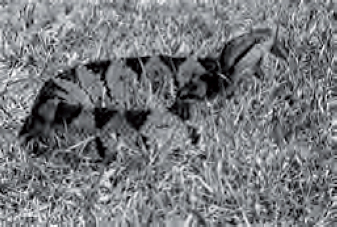

Habitat: Found in rain forests, on plantations, and on wooded hillsides.
Length: Average 60 centimeters, maximum 120 centimeters.
Distribution: Southern Mexico, Honduras, Guatemala, Costa Rica, Panama, and El Salvador.
Mojave rattlesnake
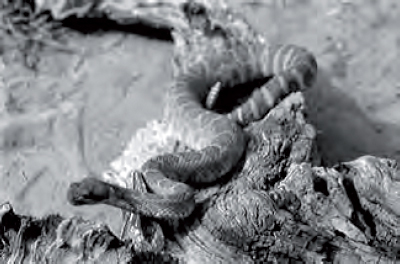

Crotalus scutulatus
Description: This snake’s entire body is a pallid or sandy odor with darker diamond-shaped markings bordered by Lighter-colored scales and black bands around the tail.
Characteristics: Although this rattlesnake is of moderate size, its bite is very serious. Its venom has quantities of neurotoxic elements that affect the central nervous system. Deaths have resulted from this snake’s bite.
Habitat: Found in arid regions, deserts, and rocky hillsides from sea level to 2400-meter elevations.
Length: Average 75 centimeters, maximum 1.2 meters.
Distribution: Mojave Desert in California, Nevada, southwest Arizona, and Texas into Mexico.
Tropical rattlesnake
Crotalus terrificus
Description: Coloration is light to dark brown with a series of darker rhombs or diamonds bordered by a buff color.
Characteristics: Extremely dangerous with an irritable disposition, ready to strike with little or no warning (use of its rattle). This species has a highly toxic venom containing neurotoxic and hemotoxic components that paralyze the central nervous system and cause great damage to tissue.
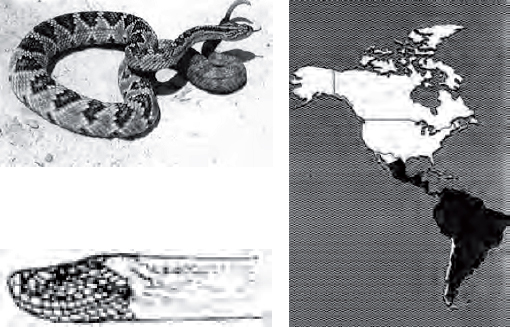
Habitat: Found in sandy places, plantations, and dry hillsides.
Length: Average 1.4 meters, maximum 2.1 meters.
Distribution: Southern Mexico, Central America, and Brazil to Argentina.
Western diamondback rattlesnake
Crotalus atrox
Description: The body is a light buff color with darker brown diamond-shaped markings. The tail has heavy black and white bands.
Characteristics: This bold rattlesnake holds its ground. When coiled and rattling, it is ready to defend itself. It injects a large amount of venom when it bites, making it one of the most dangerous snakes. Its venom is hemotoxic, causing considerable pain and tissue damage.
Habitat: It is a very common snake over its range. It is found in grasslands, deserts, woodlands, and canyons.
Length: Average 1.5 meters, maximum 2 meters.
Distribution: Southeast California, Oklahoma, Texas, New Mexico, and Arizona.
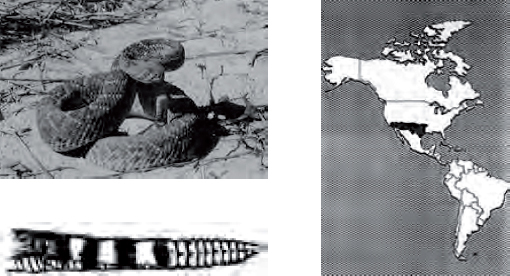
POISONOUS SNAKES OF EUROPE
Common adder
Vipera berus
Description: Its color is variable. Some adult specimens are completely black while others have a dark zigzag pattern running along the back.
Characteristics: The common adder is a small true viper that has a short temper and often strikes without hesitation. Its venom is hemotoxic, destroying blood cells and causing tissue damage. Most injuries occur to campers, hikers, and field workers.
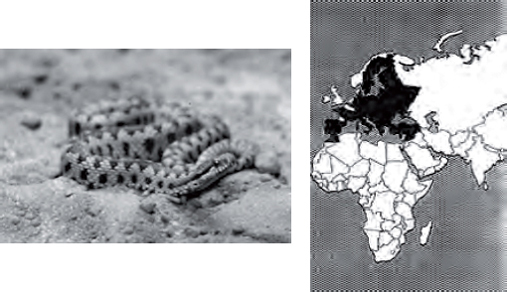
Habitat: Common adders are found in a variety of habitats, from grassy fields to rocky slopes, and on farms and cultivated lands.
Length: Average 45 centimeters, maximum 60 centimeters.
Distribution: Very common throughout most of Europe.
Long-nosed adder
Vipera ammodytes
Description: Coloration is gray, brown, or reddish with a dark brown or black zigzag pattern running the length of its back. A dark stripe is usually found behind each eye.
Characteristics: A small snake commonly found in much of its range. The term “long-nosed” comes from the projection of tiny scales located on the tip of its nose. This viper is responsible for many bites. Deaths have been recorded. Its venom is hemotoxic, causing severe pain and massive tissue damage. The rate of survival is good with medical aid.
Habitat: Open fields, cultivated lands, farms, and rocky slopes.